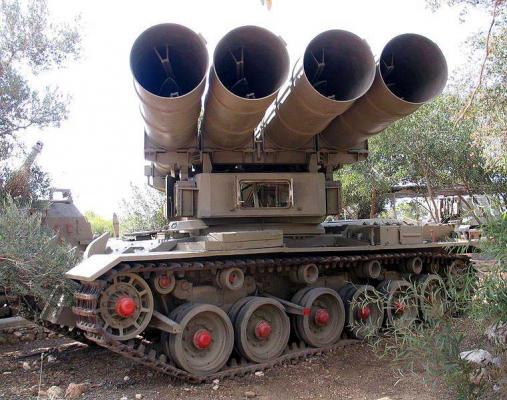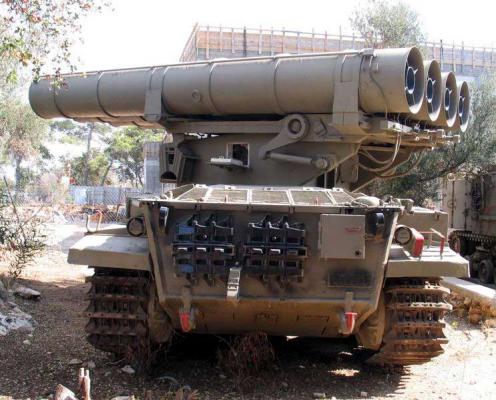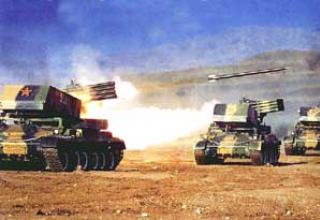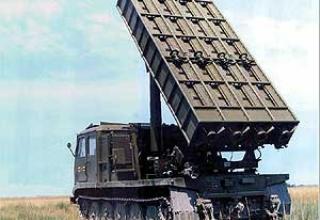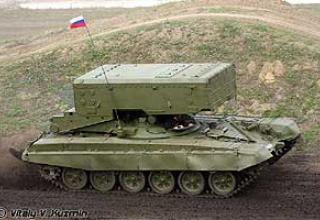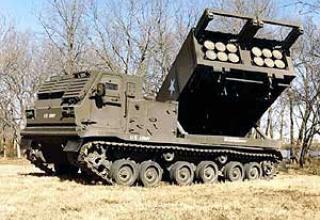Izrael Military Industries (IMI) has developed and adopted for service with the Israel Defense Forces (IDF) the 290 mm MAR-290 MLRS for target acquisition at ranges from 10 to 25 km.
The first variants of MAR-290 MLRS vehicles, called Ivry, were made on the chassis of Sherman M-51 tank. The projectiles were launched from a four-charged frame launcher.
The first MAR-290 "Ivry" systems were handed over to the Israel Defense Forces (IDF) in 1973. They did not participate in the Doomsday war (although they were already in service), the first combat use was in the 1982 war in Lebanon (in particular, the system was used to strike at the Syrian SAMs and, according to the Israeli side, played a significant role in their destruction).
By the beginning of the 80s a new version of the "Ivry" ("dor sheni" - "second generation") was created on the basis of the "Centurion" tank, with tubular guides and a new recharge system.
Currently, the MAR-290 MLRS based on the Centurion tank is in service with the API in the amount of 20 pieces.
Composition:
MAR-290 includes:
- launcher (PU),
- 290mm unguided rockets (NURS),
- fire control system,
- charger,
- a transport vehicle.
The launcher is mounted on a modified tracked chassis of the English Centurion tank. The artillery piece of the launcher is mounted in place of the removed turret of the tank and represents a swivel platform on which a package of four tubular rails is mounted. The platform is rotated and the rails are guided vertically by hydraulic drives. The rails package has a circular firing sector and an elevation angle of 0° to 60°. Diameter of tubular guideway is 700 mm, length is 6000 mm. Time of full salvo - 10s. The calculation includes the commander, the mechanic-driver and two operators of fire control. At firing all numbers of calculation are in the fighting vehicle. The battery includes 4-5 PU.
The engine and transmission compartment of the tracked chassis is equipped with a twelve-cylinder carburetor engine "Meteor" by Rolls-Royce. The engine has a liquid-cooling system. At 2500 rpm it develops a maximum power of 640 hp. Transmission is manual with a five-speed gearbox. The chassis includes six supporting and supporting rollers from each side. Suspension of the supporting rollers is blocked. Each of the two rollers in the bogie is mounted on a two-shoulder balancer. The drive wheels are at the rear. Metal track with open hinges. When driving on the highway launcher develops a relatively low speed - 34.6 km / h. On rough terrain it overcomes 0.91 m high walls and 3.35 m wide ditches. It overcomes walls 0.91m high and ditches 3.35m wide without any preliminary preparation and fords up to 1.45m deep.
The PU is equipped with radio communication facilities and tank intercom, and has a system of firefighting equipment. The auxiliary armament consists of a 7.62mm Browning machine gun mounted in front of the driver's hatch.
Shots are fired from 290 mm NURS, stabilised in flight by four-blade stabilisers. The projectile length is 5.45m, weight is 600kg, weight of the combat unit is 320kg. Currently, there is information about the presence of only a shrapnel-flagged combat unit. Maximum range of fire is 25 km. In the Mk4 version, the missile range was increased to 40 km. The Mk4 was used for research and development, and there are no data on serial production.
The PU is recharged using an original mechanism, which is mounted in the recharging position on the starter unit and connected to its hydraulic system. The NURS are transported to the recharging position by a transport and charging machine equipped with an on-board crane with the help of which the projectiles are placed on a special frame. When the PU is charged by means of a system of two grippers and brackets in the front of the hull, it meshes with the mating parts on the frame. The frame is then connected to the hydraulic system of the launcher and the hoist lifts the frame from NURS horizontally to the charging line with a pack of rails, after which NURS is sent to the rails (see photo). One combat calculation number can reload the launcher in 10 minutes.
Characteristics:
| Caliber,mm | 290 |
| NURS Length,mm | 5450 |
| Weight NURS, kg | 600 |
| Finger scale, mm | 570 |
| Maximum firing range, km | 25 (Mk4 -40) |
| Number of guides | 4 |
| Weight of combat vehicle, kg | 50800 |
| Overall dimensions, mm - length - width - altitude |
7560 3400 3600 |
| Recharging time, min | 10 |
| Maximum speed, km/h | 34.6 |
| Power reserve, km | 190 |
Testing:
MTUR "Malyutka" was very successfully used during the Arab-Israeli War in 1973, it was with its help that almost the entire Israeli tank fleet was destroyed - about 800 vehicles. Only on October 6, 1973, for example, the 252nd Israeli Tank Division was defeated - more than a hundred vehicles were hit.
Sources:
- Шунков В.Н. "Ракетное оружие" .-Мн.: ООО "Попурри", 2001- 528с.
- Нестеренко В. "Реактивные системы залпового огня армий капиталистических стран" .Зарубежное военное обозрение №5,1991
- Гуров С.В. "Реактивные системы залпового огня" .-Тула.: "Пересвет", 2006- 432с.
- "Beyt ha-Totchan Museum"
- "Самоходная артиллерия и минометы АОИ (http://www.waronline.org)
